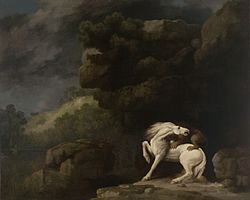For Thursday Art-Day we look at the fantastic work of George Stubbs…
George Stubbs (25 August 1724 – 10 July 1806) was an English painter best known for his paintings of horses.
Stubbs was born in Liverpool, the son of a currier and leather merchant. Stubbs worked at his father’s trade until he was 15 or 16, and after his father’s death in 1741 was briefly apprenticed to a Lancashire painter and engraver named Hamlet Winstanley. He apparently objected to the work of copying to which he was set and left. Thereafter as an artist he was self-taught. In the 1740s he worked as a portrait painter in the North of England and from about 1745 to 1751 he studied human anatomy at York County Hospital.
 Whistlejacket 1762 National Gallery London
Whistlejacket 1762 National Gallery London
In 1754 Stubbs visited Italy. Forty years later he told Ozias Humphry that his motive for going to Italy was, “to convince himself that nature was and is always superior to art whether Greek or Roman, and having renewed this conviction he immediately resolved upon returning home”. In 1756 he rented a farmhouse in the village of Horkstow, Lincolnshire, and spent 18 months dissecting horses, assisted by his common-law wife, Mary Spencer. He moved to London in about 1759 and in 1766 published The anatomy of the Horse. The original drawings are now in the collection of the Royal Academy.
 Mares and Foals in a landscape 1768-68
Mares and Foals in a landscape 1768-68
Even before his book was published, Stubbs’s drawings were seen by leading aristocratic patrons, who recognised that his work was more accurate than that of earlier horse painters such as James Seymour, Peter Tillemans and John Wootton. In 1759 the 3rd Duke of Richmond commissioned three large pictures from him, and his career was soon secure. By 1763 he had produced works for several more dukes and other lords and was able to buy a house in Marylebone, a fashionable part of London, where he lived for the rest of his life.
A grey hunter with groom and greyhound at Creswell Crags circa 1762-4 (a personal favourite..wish list!)
His most famous work is probably Whistlejacket, a painting of a prancing horse commissioned by the 2nd Marquess of Rockingham, which is now in the National Gallery in London. This and two other paintings carried out for Rockingham break with convention in having plain backgrounds. Throughout the 1760s he produced a wide range of individual and group portraits of horses, sometimes accompanied by hounds.
A Lion attacking a Horse 1770 Yale University Art Gallery
He often painted horses with their grooms, whom he always painted as individuals. Stubbs also painted more exotic animals including lions, tigers, giraffes, monkeys, and rhinoceroses, which he was able to observe in private menageries. He became preoccupied with the theme of a wild horse threatened by a lion and produced several variations on this theme. These and other works became well known at the time through engravings of Stubbs’s work, which appeared in increasing numbers in the 1770s and 1780s.
 A couple of Foxhounds 1792
A couple of Foxhounds 1792
Also in the 1770s he painted single portraits of dogs for the first time, while also receiving an increasing number of commissions to paint hunts with their packs of hounds. He remained active into his old age. Stubbs’s died at the age of 81 on 10 July 1806, in London.
For more www.wikipedia.org


Leave a Reply